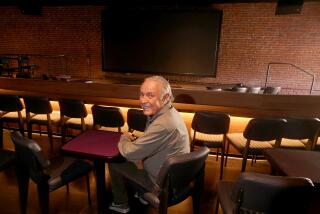Buss Sells a 1-Cent Stamp for $380,000
- Share via
There are only two known to exist, and Jerry Buss, owner of the Kings, Lakers and Forum, had one. Monday night, he sold it.
When the final auction hammer fell, Buss’ 1867 U.S. postage stamp--known as the “1-cent Z grill” and coveted by philatelists worldwide--brought $380,000, the second-highest price ever paid for a single stamp. The winning bid came from Andrew Levitt, a stamp dealer from Danbury, Conn., representing an East Coast industrialist whom auctioneers did not identify.
The record is held by the legendary, one-of-a-kind 1856 British Guiana 1-cent magenta-colored stamp which was sold to an anonymous collector in New York City in 1980 for $935,000, including sales commission.
The sale of Buss’ prize light-blue stamp, displaying a bust of Benjamin Franklin facing right, came in a mega-buck stamp auction at the Century Plaza Hotel. In just a few hours Monday evening, 1,034 lots of stamps were sold for a total of $950,000, plus a 10% sales commission.
Buss, 52, who became familiar with collectible stamps as a teen-ager while running a stamp mail-order business in Kemmerer, Wyo., said he hasn’t had time to maintain his collection.
“It belongs in the hands of an active collector,” he said through a spokesman. “I haven’t been able to devote any time to this hobby in the last seven or eight years. I thought it should be put back into the stamp world.”
In recent years, Buss has sold some of his real estate holdings, and his multimillion-dollar Beverly Hills mansion, “Pickfair,” which formerly belonged to Mary Pickford and Douglas Fairbanks, is currently for sale.
According to Michael Orenstein, stamp manager for Superior Stamp & Coin Co. of Beverly Hills, which conducted Monday’s auction, the “1-cent Z grill” was the product of an experiment by postal authorities to prevent the reuse of stamps after they were canceled. Nobody knows how many were printed, he said, but collectors have only found two.
The code-like “Z” designation refers to the size and shape of the “grill” on the reverse side of the 1-cent stamp. The grill was a waffle-like impression which broke the stamp paper’s fibers so that cancellation ink could not be washed off. Hence the name, “1-cent Z grill.”
Cancellation Mark
The Buss stamp--which bears a partial Philadelphia cancellation mark, believed to be from 1867--was particularly exciting to philatelists attempting to build a complete United States stamp collection. About 2,200 regular and commemorative stamps have been issued by the U.S. Postal Service since it went into the stamp business in 1847.
But no collection is complete without the “1-cent Z grill,” said Orenstein.
The only individual known to have put together such a collection was Minneapolis businessman William Schilling, from whom Superior acquired the “1-cent Z grill” in 1977 at a Sotheby Parke Bernet auction for $90,000. Superior then sold the stamp to Buss for $100,000, Orenstein said.
The only other “1-cent Z grill” known to exist is in the Benjamin K. Miller stamp collection in the New York Public Library.
The closest anyone else is known to have come to building a complete United States stamp collection, Orenstein said, is the one amassed by Ryo Ishikawa, a Japanese taxicab mogul. “He has everything but this stamp,” Orenstein said.
Offer Declined
Five years ago, the Japanese businessman made overtures for the Buss stamp, “offering up to one-third of a million dollars,” he said. “And Buss turned it down.”
But Ishikawa was nowhere to be seen Monday night as more than 100 stamp collectors and their representatives gathered in the Century Plaza’s Pacific Palisades Room. In just a few minutes, bidding on the Buss stamp, which had opened at $175,000, rocketed toward the $400,000 mark at increments of $20,000.
As might be expected, the buyer of the Buss stamp was understood to be attempting to put together that elusive complete United States stamp collection.
Bidding against Levitt, Orenstein said, was “a local person connected with the entertainment industry.” He would not identify him either.
Mark Goldberg, one of Superior Stamp’s owners who was conducting the auction, dropped the hammer for a final time and Levitt’s client had won the sought-after stamp. Final price: $380,000, plus a 10% auction fee for Superior.
“The buyer was prepared to go higher,” Orenstein observed, adding:
“It’s the high point of a stamp dealer’s professional career to handle a stamp like this just once. In the case of Superior, we have handled it twice. It’s all downhill from here.”
More to Read
Sign up for Essential California
The most important California stories and recommendations in your inbox every morning.
You may occasionally receive promotional content from the Los Angeles Times.













